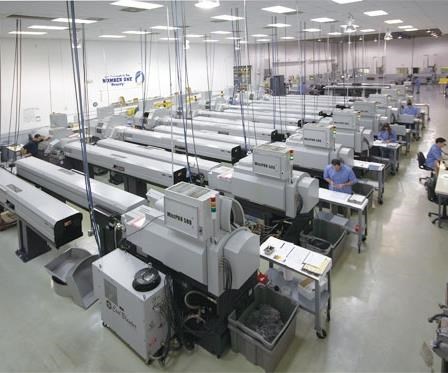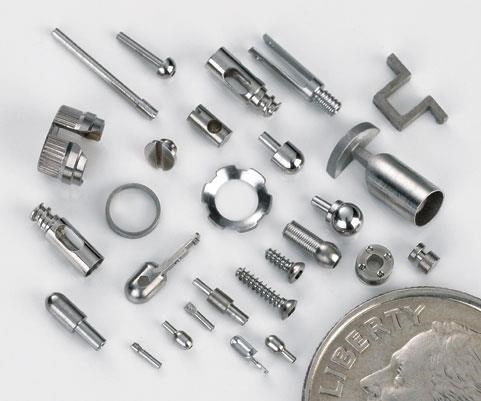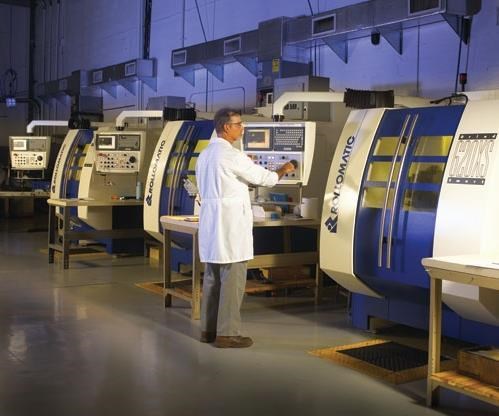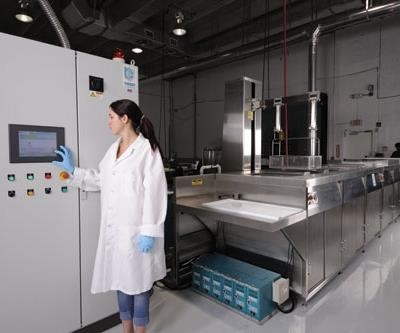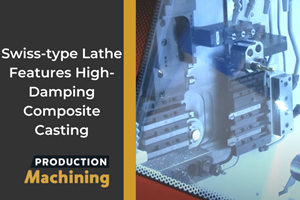Trends in Swiss Machining
This Florida medical manufacturer is an expert in the production of complex medical parts on CNC Swiss machines. Their job shop has evolved from 18 to 135 employees by efficient production of small, difficult parts for the demanding medical industry. And moving forward, the shop’s co-founder only sees better things ahead.
One of the perks of being editor-in-chief for Production Machining is that sometimes I can pick and choose among story assignments. On a recommendation from John Antignani at Marubeni Citizen-Cincom, I arranged a visit to 3-D Medical Manufacturing in Rivera Beach, Fla., in January. Granted, it was a brief visit, but to my winter-chilled bones, even just a couple of days in 75-degree sunshine act as a tonic.
In his e-mail where he passed me the lead for this article John wrote, “One of the leading and most innovative medical shops in our industry is 3-D Medical Manufacturing in Florida.” That shout-out from Mr. Antignani has everything an editor looks for: innovative shop, medical machining and, of course, Florida. I was not disappointed.
Born in the Biz
Brothers Jim and Joe Davis literally grew up in the metalworking business. Their father had a machine shop where the young brothers spent time learning about machining from the bottom up. “I remember one of my first jobs in my father’s shop was sweeping up chips,” recalls Joe Davis, executive vice president. “Gradually, we worked our way up to the drill press and manual milling machines.”
Around 1974, the brothers went to work in the shop of a friend of their father who had some early CNC machines. As Joe Davis puts it, “My dad’s thinking was for us to get some real-world experience working for someone who was not family. It was good experience, too. We were allowed to learn by doing.”
The experience cemented the boys’ future. “Our plan was to finish high school and start our own machine shop,” Joe Davis says. “Then our dad interceded and, while supportive of our ambition to start a shop, he suggested we get a college degree first. So we both got degrees in manufacturing engineering.”
That proved to be a good career move because an ME degree coupled with the brothers’ practical shop experience made them a pretty hot commodity for the machine shop job market. “Some of the guys I went to engineering college with could barely use a micrometer,” Joe Davis says. “Upon graduation, we easily found jobs.”
Jim Davis, 3-D’s president, went to work for a medical manufacturer of cardiovascular pacemakers and catheters. Brother Joe joined him there later. “Working on the pacemaker side of this company’s business was an ideal job for us,” Joe Davis says. “It was vertically integrated with all parts and assemblies manufactured in-house. We even did the packaging. It gave us a breadth of experience necessary to run a successful machine shop.”
However, after about 6 years, the medical company ran into problems and decided to downsize. So in 1987, the brothers bought out the Swiss lathe department from their employer and started the business that would become 3-D Medical Manufacturing. It was a promising start based on the brothers’ good understanding of the medical industry’s high quality standards and regulatory environment along with their grasp of metalworking in general and Swiss machining specifically.
For the first 5 months, the new shop’s only work was from their former employer’s catheters and pacemakers. But soon the business began to grow rapidly. The growth was fueled in no small way by the brothers’ correct assumption that the burgeoning medical industry needed capable and dependable suppliers.
From Cam to CNC
The precision machining department the Davis brothers purchased comprises primarily Bechler cam machines and Hardinge lathes. CNC was just getting started at the time. “I had no interest in cam machines,” Joe Davis recalls. “They were hard to set up and rather inflexible. In fact, my brother purchased one of the first CNC Swiss in the country—a Citizen F10. We cut our CNC Swiss teeth on that machine.”
By the time the brothers were up and running their shop, and then called Micro-Med, they had 18 employees from their former OEM. The shop floor comprised three CNC Swiss, seven of the Bechlers, along with some Hardinge chuckers and speed lathes for secondary work on parts the Swiss machines couldn’t complete in one handling.
Initially, the parts they were making for their former company were tiny cardiovascular parts for pacemakers. These parts were made from titanium, platinum and stainless materials.
“When we started,” Joe Davis recalls, “there were few CNC Swiss machines in job shops. In fact, most shops were somewhat dedicated to Swiss machining or multi-spindle machining or milling prismatic parts. That’s all changed now because of CNC. The cam department in the screw machine shop morphed over time into the programming department for the shop. This opened the door for CNC machines of various kinds, which greatly expanded the Swiss job shops capability. We now have five-axis machining centers, CNC tool and cutter grinders, robotic turning cells—none of which would be found in a traditional Swiss screw machine shop. Today, almost every machine shop has at least one CNC Swiss.”
As the CNC stable grew, transitioning the employees from cam setting to CNC programming was an interesting experiment in human attitudes. Eddie Pena, 3-D’s vice president for manufacturing, recalls some of the bumps in that road. “We asked some of our guys to attend training classes on the Citizen CNC, including programming, and then tasked them with training the rest of our employees when they returned. It was interesting how some of the cam guys simply refused to learn the new technology. In our case, only about 25 to 30 percent of the individuals were able to make the transition. Of course, the others are no longer here.”
Parts and Processes
The company’s business is focused on medical—99 percent of the parts it makes are used in the medical industry. As the capability of the CNC Swiss machines evolved, so did the complexity of the parts that 3-D was able to make.
Joe Davis puts it this way, “One giant technological leap for Swiss machining was the addition of reliable milling capability with live tooling. It did a couple of important things for our processing strategy, primarily the ability to finish parts in the machine and eliminate secondary ops. It also challenged our engineers and programmers to figure out ways to put machining center parts on the Swiss—parts like spinal plates, for example. If you can mill-turn a machining center part on a Swiss machine, you eliminate fixturing and workholding from the equation.”
Starting with the cardiovascular and pacemaker business, 3-D branched out into orthopedic and arthroscopic parts. These include bone screws, tiny tubes, fittings and valves as well as surgical drills, tabs, trepanning tools and bone plates.
More than 60 percent of the parts that 3-D manufactures require milling, drilling or both. Some of the crossholes are 0.005 inch in diameter. One example is a tubular part that requires a 0.004-inch center hole drilled 1.5 inches deep with a wall thickness of 0.007 inch in titanium. Medical machining is not for the faint of heart.
The ability to process these parts complete on the CNC Swiss machine helps the company meet the strict cosmetic requirements of the medical industry. “Our parts must be accurate and burr-free, but almost as important in medical is they must look good,” Joe Davis says.
Moving Forward
When CNC Swiss first came to the market, many of the shops that bought the early machines used them like a cam machine. They would dedicate the machine to a job and run it. “It was like buying a Ferrari and never getting it out of second gear,” Joe Davis says. “A car like that should be driven and put through its paces to take advantage of its capabilities. Likewise, CNC Swiss machines are flexible and quickly set up for high mix job runs. We run lot sizes of 350 to 400 and turn each of our 32 Citizens twice a week, on average.”
As the CNC Swiss machine has developed, the capabilities built into the machines have become amazing: seven, eight and 11 axes under CNC control, synchronized subspindles, polygon turning, C-axis contouring, whirling attachments, wobble broaching, live tooling, high speed pencil spindles and more. However, the job shop is still about matching the right tool to the application and producing parts cost effectively.
“Today’s CNC Swiss machines, in some cases, have capabilities that exceed the application,” Joe Davis says. “The challenge is to find jobs that can use the capabilities of the machine you put it on. While we have 32 Citizens on our floor and run parts from 0.062 to 1.25-inch stock, we have a variety of models and options to try to match the job complexity to the machine capability. It’s just more efficient. In other words, why put a job that needs only three-axis capability on an 11-axis machine?”
Interestingly, in the last 5 years many of the Swiss machine builders have responded to this trend with relatively simpler models to help shops better fit capability to application. It’s analogous to Sears’ old “good, better, best” tier system, only for machine tools, it’s about few, several or many bells and whistles.
The company runs two manned shifts, and one lights-out shift. All of the machines are equipped with magazine bar feeders. “We have validated our lights out shift, proving that we can run good parts over the shift,” Joe Davis says. “To do that successfully, you must have very good material. All of our stock is centerless ground to ± 0.00015 inch. Is it overkill? Probably. But the more accurate the stock, the tighter the guide bushing can be set and the more consistent the finished parts. Also, since we run so much titanium, all of our machines are equipped with Firetrace extinguisher systems. They allow me to sleep better during that unmanned shift.”
Validation is Coming
The old sarcastic bromide “We’re from the government, and we’re here to help” may be coming to your shop if medical machining is part of your production mix. In this case it’s coming in the form of the Food and Drug Administration (FDA).
Inspectors from FDA are spreading across the nation and requiring medical machine shops to validate the machining process for medical jobs—the tools, program, calibration gages. And while all these things are already controlled internally by 3-D’s quality department, because it makes for the medical industry the FDA has deemed the design and manufacturing process has to be validated to its standards. “Unfortunately, many of these inspectors know next to nothing about metalworking,” Joe Davis says.
“A typical validation,” he continues, “consists of running three lots of a specified quantity of parts, say 500 pieces, on your machine and when you finish the first lot, the machine is completely broken down—tools removed, program dumped, the power is shut off. Next, you power up the machine, load the tools, load the program, run the first article then machine the second batch of 500, then the third. During the runs, you collect as much data as possible, way more than normal, and this data is analyzed to confirm the specified Cpk value has been hit. For example, you might put a tach on the spindle to validate the programmed rpm is the actual rpm. Even the CNC has to be validated.”
This validation initiative is actually coming from 3-D’s medical customers who in turn have been hammered by the FDA. Basically, Joe Davis warns, if shops are not going through validation yet, they will be. Once the process is validated, it can’t be changed. If a change is made, then a change justification must be submitted. Sometimes a change can require a re-validation of that process.
Joe Davis cites the shop’s new Crest ultrasonic parts cleaning system. “The cleaning system has been on my floor for a month now, and I won’t have it validated for another 2 months. I have to make dummy parts to satisfy the validation protocol. Ten years ago, I would have had that thing running the day it hit my floor.
“If carried to its potential extreme, I see validation as an innovation killer,” Joe Davis continues. “Long term, medical machine shops may employ less efficient, but validated processes to avoid the bureaucratic hassle of change justification and revalidation. It already happens in aerospace.”
Related Content
PMTS 2023 Product Preview: Swiss-Types
Learn about some of the latest Swiss-type solutions that will be on display at PMTS 2023.
Read MoreSoftware Controls Chip Breaking in Thread Turning Operations
This cutting tool manufacturer has developed a software module for chip control of thread turning operations in virtually any CNC lathe, even for older machines, using specific tooling and software.
Read MoreVideo Tech Brief: Swiss-type Lathe Features High-Damping Composite Casting
A rigid casting design and chip control technology are among the various benefits of this Swiss-type lathe.
Read MoreSwiss Rejuvenation Doubles Shop Productivity
As he progressed to CNC Swiss lead and later to his current position as CNC Swiss production supervisor, Darrin Baker helped the Swiss department at Liberty Precision double its productivity, according to his nominator.
Read MoreRead Next
Seeing Automated Workpiece Measurement in Real Time
User-friendly inspection software for CNC machining centers was shown at IMTS 2024 monitoring measurements between and after machining while performing SPC based on recorded measurement values.
Read More5 Aspects of PMTS I Appreciate
The three-day edition of the 2025 Precision Machining Technology Show kicks off at the start of April. I’ll be there, and here are some reasons why.
Read MoreA Tooling Workshop Worth a Visit
Marubeni Citizen-Cincom’s tooling and accessory workshop offers a chance to learn more about ancillary devices that can boost machining efficiency and capability.
Read More


